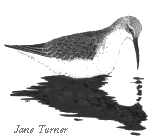July
It may only be mid-summer
but for many species July marks the end of the breeding season. This means a
big influx into the estuary, especially gulls and terns which use the sand
banks and calm seas of the estuary as a post breeding gathering place.
Sandwich terns are the first of the terns to finish breeding and there is a
rapid build up of numbers during the month. Their nearest breeding colonies
are in Cemlyn Bay, Anglesey, and Morecambe Bay - about 600 pairs altogether.
They quickly disperse from these breeding sites and we get up to a
thousand roosting at low tide around Hilbre
Island, and at high tide at Gronant,
Point of Ayr,
West Kirby and Hoylake. Although the
Little Terns at Gronant are several weeks
behind their bigger cousins the chicks will be starting to fledge by the end
of the month. Most years we get a large influx of Little Terns during July,
perhaps failed breeders from elsewhere, resulting in a total flock of 400
birds.
Waders start to return with a rapid build up of Redshank and Curlew, both of
which breed in this country. But even those breeding further north start to
pass through with Sanderling and Dunlin seen at
Hoylake and
Gronant. Less common waders often turn up - Green Sandpiper, Wood
Sandpiper, Greenshank and Whimbrel are all regular in July. The Black-tailed
Godwits at Inner Marsh Farm, up to 500 or
so, are famous for being the largest over summering flock in the country.
Sea watching can be great in July, given a strong west wind we get lots of
Gannets, Manx Shearwater and Common Scoter. Arctic Skuas are often about and
this is one of the best months to see Storm Petrels. All in all a great, and
much underrated, month for birdwatching.

August
Large numbers of waders will be coming through on
passage. These are birds which will winter far to the south - expect to see
flocks of up to a thousand of Ringed Plover and Sanderling, and several
thousand of Dunlin. A few Curlew Sandpipers should turn up, may be an adult
or two earlier on in the month and juveniles towards the end. The return
passage of Whimbrel peaks in August, best seen from
Hilbre.
Both Green and Common Sandpipers occur in small numbers preferring fresh
water to salt e.g. Inner Marsh Farm. The
Boathouse Flash at Parkgate has become one
of the best places in the country to see Greenshank and numbers should build
up all month to a peak of between 60 and 100+.
Whilst Sandwich Terns disperse away from the estuary a steady passage of
Common Terns will build up with several hundred a day being seen towards the
end of the month. The end of the breeding season at
Gronant
should also result in a hundred or so Little Terns visiting the mouth of the
estuary.
August also marks the southwards migration of Marsh Harriers and two to
three are often seen at Inner Marsh Farm or
over the marshes off Burton and
Flint.

September
The north Wirral coast,
Hilbre and Point
of Ayr have the reputation for bring the best place in the country for
seeing Leach's Petrels. But the weather has to be right, ideally we need at
least two consecutive days of strong north west winds in the middle two
weeks of September. This blows hundreds of Leach's Petrels into the Irish
sea straight towards the mouth of the River Mersey, they then have to fly
westwards along the Wirral coast towards the Point
of Ayr, right in front of the assembled birdwatchers! Of course sea
watching generally will be very good in these conditions with the occasional
Sabine's Gull turning up, along with all four species of Skuas - Arctic,
Great, Pomarine and Long-tailed.
Curlew Sandpipers and Little Stints will be passing through, usually more of
the former at the beginning of the month. Greenshank numbers will remain
high at Parkgate throughout the month, the
record count of 104 was on Sept. 4th in 2001.
One or two Osprey may pass through on their way south. Shelduck numbers
rapidly build up after their moult on the Mersey estuary. A good place to
see Great Crested Grebes is off
Greenfield
dock at low tide, over 100 can sometimes be seen in September, best seen on
a windless day.
Although these days Little Egrets stay on the estuary all year round there
is a post breeding influx in September, probably best seen on Burton marsh.
Spotted Crakes are rare rails most of which winter south of the Sahara. Most
years we get one or two staying a few days at
Inner Marsh Farm on their way south. |

